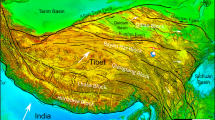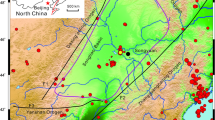Abstract
On May 12, 2008 at 14:28, a catastrophic magnitude M s 8.0 earthquake struck the Sichuan Province of China. The epicenter was located at Wenchuan (31.00°N, 103.40°E). Liquefaction macrophenomena and corresponding destruction was observed throughout a vast area of 500 km long and 200 km wide following the earthquake. This paper illustrates the geographic distribution of the liquefaction and the relationship between liquefaction behavior and seismic intensity, and summarizes the liquefaction macrophenomena, including sandboils and waterspouts, ground subsidence, ground fissures etc., and relevant liquefaction features. A brief summary of the structural damage caused by liquefaction is presented and discussed. Based on comparisons with liquefaction phenomena observed in the 1976 Tangshan and 1975 Haicheng earthquakes, preliminary analyses were performed, which revealed some new features of liquefaction behavior and associated issues arising from this event. The site investigation indicated that the spatial non-uniformity of liquefaction distribution was obvious and most of the liquefied sites were located in regions of seismic intensity VIII. However, liquefaction phenomena at ten different sites in regions of seismic intensity VI were also observed for the first time in China mainland. Sandboils and waterspouts ranged from centimeters to tens of meters, with most between 1 m to 3 m. Dramatically high water/sand ejections, e.g., more than 10 m, were observed at four different sites. The sand ejections included silty sand, fine sand, medium sand, course sand and gravel, but the ejected sand amount was less than that in the 1976 Tangshan earthquake. Possible liquefaction of natural gravel soils was observed for the first time in China mainland.
Similar content being viewed by others
References
Harder JF (1997), “Application of the Becker Penetration Test for Evaluating the Liquefaction Potential of Gravelly Soils,” Proceedings of NCEER Workshop on Evaluation of Liquefaction Resistance of Soils, National Center for Earthquake Engineering Research, Buffalo.
Harder JF and Seed HB (1986), “Determination of Penetration Resistance for Course-grained Soils Using the Becker Hammer Drill,” Report UCB/EERC-86/06, Earthquake Engineering Research Center, University of California, Berkeley.
He Yinwu (1992), “The Age of Formation of the Chengdu Basin and Features of Its Early Deposits,” Geological Review, 38: 149–156. (in Chinese)
Hu Yuxian (1988), Earthquake Engineering, Beijing: Seismic Press. (in Chinese)
Institute of Engineering Mechanics (1979), The Haicheng Earthquake Damages, Beijing: Seismic Press. (in Chinese)
Kramer SL (1996), Geotechnical Earthquake Engineering, New York: Prentice Hall.
Ku Chih-Sheng, Lee Der-Her and Wu Jian-Hong (2004), “Evaluation of Soil Liquefaction in the Chi-Chi Taiwan Earthquake Using CPT,” Soil Dynamics and Earthquake Engineering, 24: 659–673.
Li Xuening, Liu Huishan and Zhou Genshou (1992), “Study on Shake-reducing Effect of Liquefiable Layers,” Earthquake Engineering and Engineering Vibration, 12(3): 84–91. (in Chinese)
Liao Zhenpeng (1989), Seismic Microzonation, Beijing: Seismic Press. (in Chinese)
Lin Huaguo, Jia Zhaohong and Zhang Lili (2007), “Study on the Method of Sand Liquefaction Evaluation,” Geotechnical Engineering Technique, 2(21): 89–93. (in Chinese)
Liu Huixian et al (2002), The Great Tangshan Earthquake of 1976, Published by Earthquake Engineering Research Laboratory, California Institute of Technology, CA.
Robertson PK and Fear CE (1995), “Liquefaction of Sands and Its Evaluation,” Proceedings of 1st international Conference on Earthquake Geotechnical Engineering, Tokyo.
Seed HB (1979), “Soil Liquefaction and Cyclic Mobility Evaluation for Level Ground During Earthquake,” Journal of Geotechnical Engineering Division, ASCE, 105(2): 201–255.
Seed HB and Idriss IM (1971), “Simplified Procedure for Evaluating Soil Liquefaction Potential,” Journal of the Soil Mechanics and Foundation Division, ASCE, 97(9): 1249–1273.
Shibata T and Teparaska W (1988), “Evaluation of Liquefaction Potentials of Soils Using Cone Penetration Test,” Soils and Foundations, 28(2): 49–60.
Youd TL (1984), “Recurrence of Liquefaction at the Same Site,” Proceedings of the 8th World Conference on Earthquake Engineering, Vol. 3, pp. 231–238.
Youd TL, Idriss IM, Andrus RD et al. (2001), “Liquefaction Resistance of Soils,” Summary and Report from the 1996 NCEER and 1998 NCEER/NSF Workshops on Evaluation of Liquefaction Resistance of Soils, State University of New York at Buffalo.
Author information
Authors and Affiliations
Corresponding author
Additional information
Supported by: National Natural Science Foundation of China Under Grant No.50638010; the Foundation of Ministry of Education for Innovation Group Under Grant No. IRT0518
Rights and permissions
About this article
Cite this article
Chen, L., Yuan, X., Cao, Z. et al. Liquefaction macrophenomena in the great Wenchuan earthquake. Earthq. Eng. Eng. Vib. 8, 219–229 (2009). https://doi.org/10.1007/s11803-009-9033-4
Received:
Accepted:
Published:
Issue Date:
DOI: https://doi.org/10.1007/s11803-009-9033-4




